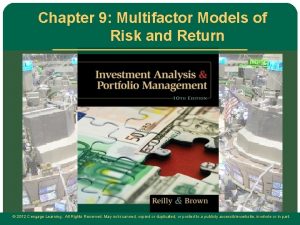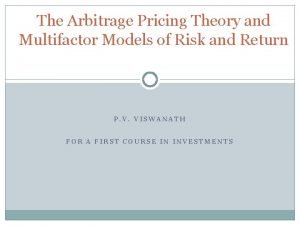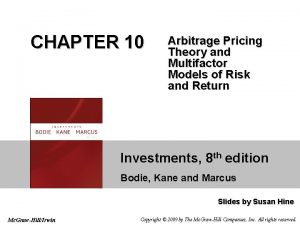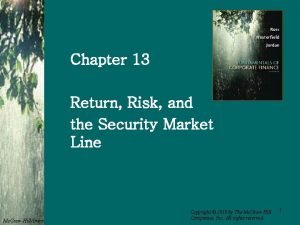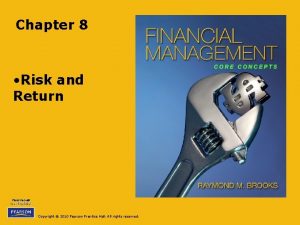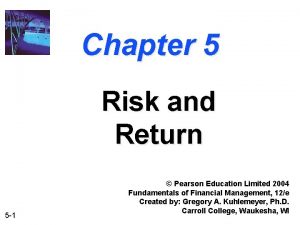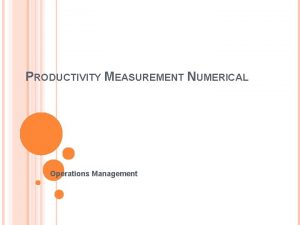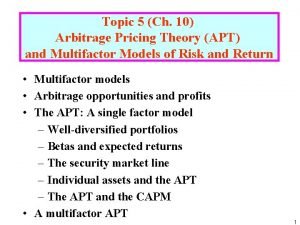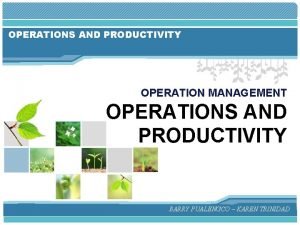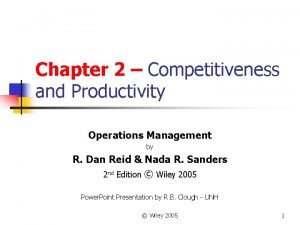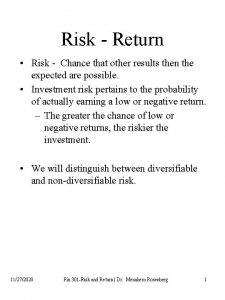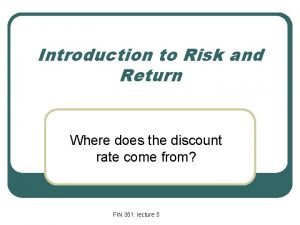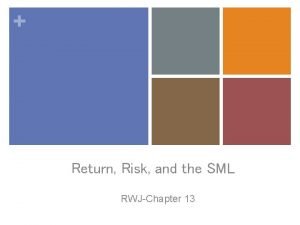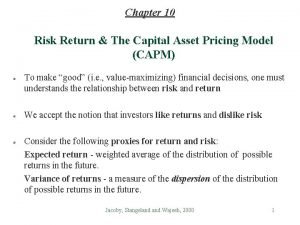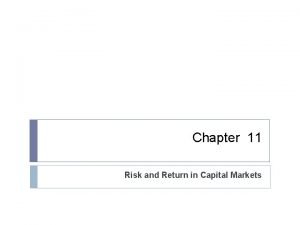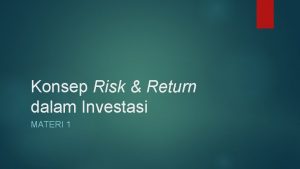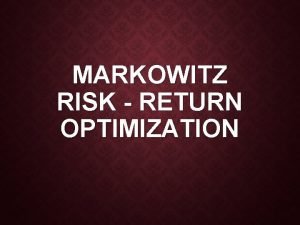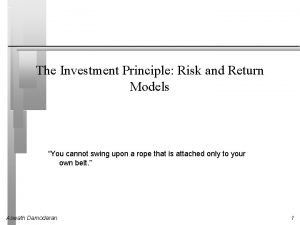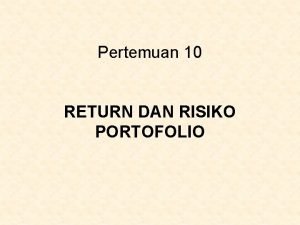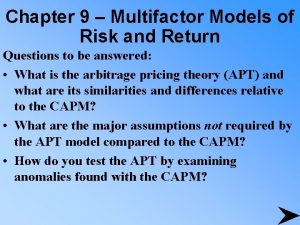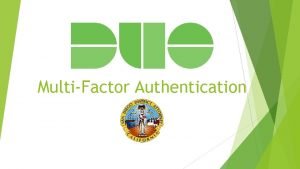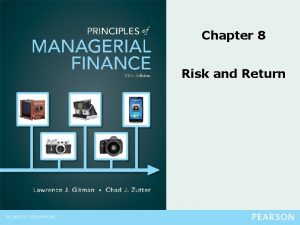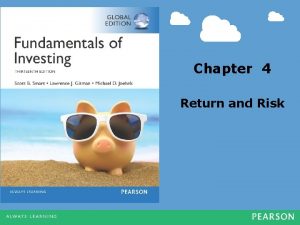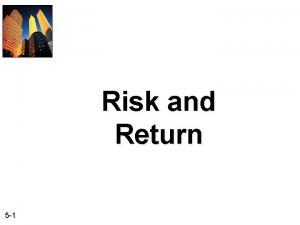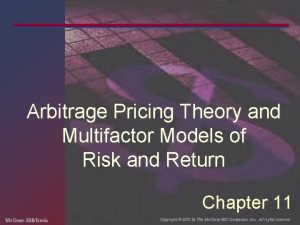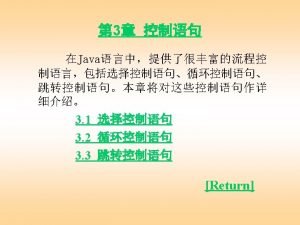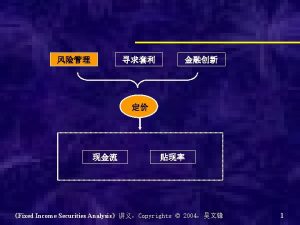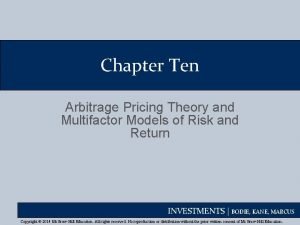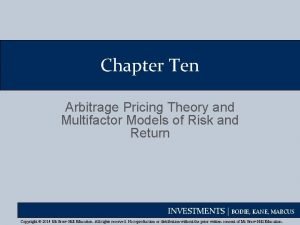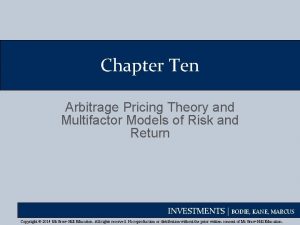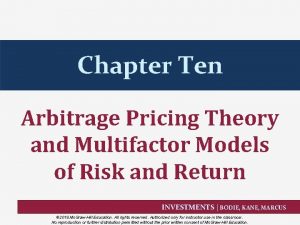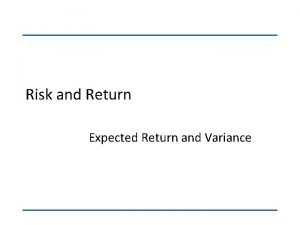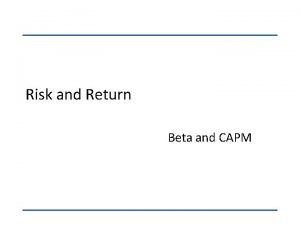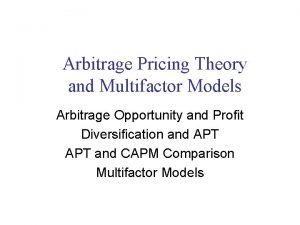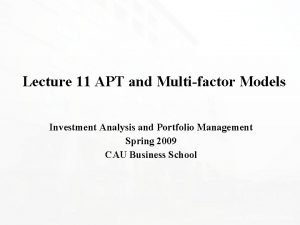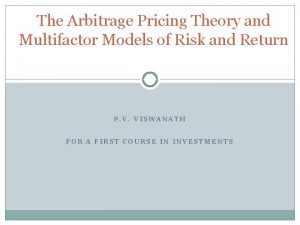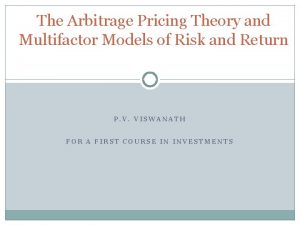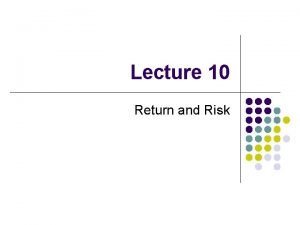Chapter 9 Multifactor Models of Risk and Return































- Slides: 31

Chapter 9: Multifactor Models of Risk and Return © 2012 Cengage Learning. All Rights Reserved. May not scanned, copied or duplicated, or posted to a publicly accessible website, in whole or in part.

Arbitrage Pricing Theory • CAPM is criticized because of – The many unrealistic assumptions – The difficulties in selecting a proxy for the market portfolio as a benchmark • An alternative pricing theory with fewer assumptions was developed: Arbitrage Pricing Theory (APT) 9 -2 © 2012 Cengage Learning. All Rights Reserved. May not scanned, copied or duplicated, or posted to a publicly accessible website, in whole or in part.

Arbitrage Pricing Theory • Three Major Assumptions: – Capital markets are perfectly competitive – Investors always prefer more wealth to less wealth with certainty – The stochastic process generating asset returns can be expressed as a linear function of a set of K factors or indexes • In contrast to CAPM, APT doesn’t assume – Normally distributed security returns – Quadratic utility function – A mean-variance efficient market portfolio 9 -3 © 2012 Cengage Learning. All Rights Reserved. May not scanned, copied or duplicated, or posted to a publicly accessible website, in whole or in part.

Arbitrage Pricing Theory • The APT Model E(Ri)=λ 0+ λ 1 bi 1+ λ 2 bi 2+…+ λkbik where: λ 0=the expected return on an asset with zero systematic risk λj=the risk premium related to the j th common risk factor bij=the pricing relationship between the risk premium and the asset; that is, how responsive asset i is to the j th common factor 9 -4 © 2012 Cengage Learning. All Rights Reserved. May not scanned, copied or duplicated, or posted to a publicly accessible website, in whole or in part.

Arbitrage Pricing Theory • A Comparison with CAPM – In CAPM, the relationship is as follows: E(Ri)=RFR + βi[(E(RM-RFR)] – Comparing CAPM and APT (Exhibit 9. 1) Form of Equation Number of Risk Factors Factor Risk Premium Factor Risk Sensitivity “Zero-Beta” Return CAPM APT Linear 1 [E(RM) – RFR] βi RFR Linear K (≥ 1) {λj} {bij} λ 0 9 -5 © 2012 Cengage Learning. All Rights Reserved. May not scanned, copied or duplicated, or posted to a publicly accessible website, in whole or in part.

Arbitrage Pricing Theory • More Discussions on APT – Unlike CAPM that is a one-factor model, APT is a multifactor pricing model – However, unlike CAPM that identifies the market portfolio return as the factor, APT model does not specifically identify these risk factors in application – These multiple factors include § § Inflation Growth in GNP Major political upheavals Changes in interest rates 9 -6 © 2012 Cengage Learning. All Rights Reserved. May not scanned, copied or duplicated, or posted to a publicly accessible website, in whole or in part.

Using the APT • Selecting Risk Factors – As discussed earlier, the primary challenge with using the APT in security valuation is identifying the risk factors – For this illustration, assume that there are two common factors § First risk factor: Unanticipated changes in the rate of inflation § Second risk factor: Unexpected changes in the growth rate of real GDP 9 -7 © 2012 Cengage Learning. All Rights Reserved. May not scanned, copied or duplicated, or posted to a publicly accessible website, in whole or in part.

Using the APT • Determining the Risk Premium – λ 1: The risk premium related to the first risk factor is 2 percent for every 1 percent change in the rate (λ 1=0. 02) – λ 2: The average risk premium related to the second risk factor is 3 percent for every 1 percent change in the rate of growth (λ 2=0. 03) – λ 0: The rate of return on a zero-systematic risk asset (i. e. , zero beta) is 4 percent (λ 0=0. 04) 9 -8 © 2012 Cengage Learning. All Rights Reserved. May not scanned, copied or duplicated, or posted to a publicly accessible website, in whole or in part.

Using the APT • Determining the Sensitivities for Asset X and Asset Y – bx 1 = The response of asset x to changes in the inflation factor is 0. 50 (bx 1 0. 50) – bx 2 = The response of asset x to changes in the GDP factor is 1. 50 (bx 2 1. 50) – by 1 = The response of asset y to changes in the inflation factor is 2. 00 (by 1 2. 00) – by 2 = The response of asset y to changes in the GDP factor is 1. 75 (by 2 1. 75) 9 -9 © 2012 Cengage Learning. All Rights Reserved. May not scanned, copied or duplicated, or posted to a publicly accessible website, in whole or in part.

Using the APT • Estimating the Expected Return – The APT Model =. 04 + (. 02)bi 1 + (. 03)bi 2 – Asset X E(Rx) =. 04 + (. 02)(0. 50) + (. 03)(1. 50) =. 095 = 9. 5% – Asset Y E(Ry) =. 04 + (. 02)(2. 00) + (. 03)(1. 75) =. 1325 = 13. 25% 9 -10 © 2012 Cengage Learning. All Rights Reserved. May not scanned, copied or duplicated, or posted to a publicly accessible website, in whole or in part.

Security Valuation with the APT: An Example • Three stocks (A, B, C) and two common systematic risk factors have the following relationship (Assume λ 0=0 ) E(RA)=(0. 8) λ 1 + (0. 9) λ 2 E(RB)=(-0. 2) λ 1 + (1. 3) λ 2 E(RC)=(1. 8) λ 1 + (0. 5) λ 2 • If λ 1=4% and λ 2=5%, then it is easy to compute the expected returns for the stocks: E(RA)=7. 7% E(RB)=5. 7% E(RC)=9. 7% 9 -11 © 2012 Cengage Learning. All Rights Reserved. May not scanned, copied or duplicated, or posted to a publicly accessible website, in whole or in part.

Security Valuation with the APT: An Example • Expected Prices One Year Later – Assume that all three stocks are currently priced at $35 and do not pay a dividend – Estimate the price E(PA)=$35(1+7. 7%)=$37. 70 E(PB)=$35(1+5. 7%)=$37. 00 E(PC)=$35(1+9. 7%)=$38. 40 9 -12 © 2012 Cengage Learning. All Rights Reserved. May not scanned, copied or duplicated, or posted to a publicly accessible website, in whole or in part.

Security Valuation with the APT: An Example • Arbitrage Opportunity – If one “knows” actual future prices for these stocks are different from those previously estimated, then these stocks are either undervalued or overvalued – Arbitrage trading (by buying undervalued stocks and short overvalued stocks) will continues until arbitrage opportunity disappears – Assume the actual prices of stocks A, B, and C will be $37. 20, $37. 80, and $38. 50 one year later, then arbitrage trading will lead to new current prices: E(PA)=$37. 20 / (1+7. 7%)=$34. 54 E(PB)=$37. 80 / (1+5. 7%)=$35. 76 E(PC)=$38. 50 / (1+9. 7%)=$35. 10 9 -13 © 2012 Cengage Learning. All Rights Reserved. May not scanned, copied or duplicated, or posted to a publicly accessible website, in whole or in part.

Empirical Tests of the APT • Roll-Ross Study (1980) – The methodology used in the study is as follows § Estimate the expected returns and the factor coefficients from time-series data on individual asset returns § Use these estimates to test the basic cross-sectional pricing conclusion implied by the APT – The authors concluded that the evidence generally supported the APT, but acknowledged that their tests were not conclusive 9 -14 © 2012 Cengage Learning. All Rights Reserved. May not scanned, copied or duplicated, or posted to a publicly accessible website, in whole or in part.

Empirical Tests of the APT • Extensions of the Roll-Ross Study – Cho, Elton, and Gruber (1984) examined the number of factors in the return-generating process that were priced – Dhrymes, Friend, and Gultekin (1984) reexamined techniques and their limitations and found the number of factors varies with the size of the portfolio – Roll and Ross (1984) pointed out the number of factors is a secondary issue compared to how well the model can explain the expected return 9 -15 © 2012 Cengage Learning. All Rights Reserved. May not scanned, copied or duplicated, or posted to a publicly accessible website, in whole or in part.

Empirical Tests of the APT • Extensions of the Roll-Ross Study – Dhrymes, Friend, and Gultekin (1985) repeated the prior tests with large samples and found that the unique risk can be used to predict future return. – Connor and Korajczyk (1993) developed a test that identifies the number of factors in a model that does allow the unsystematic components of risk to be correlated across assets – Harding (2008) also showed the connection between systematic and unsystematic risk factors 9 -16 © 2012 Cengage Learning. All Rights Reserved. May not scanned, copied or duplicated, or posted to a publicly accessible website, in whole or in part.

Empirical Tests of the APT • The APT and Stock Market Anomalies – Small-firm Effect § Reinganum: Results inconsistent with the APT § Chen: Supported the APT model over CAPM – January Anomaly § Gultekin and Gultekin: APT not better than CAPM § Burmeister and Mc. Elroy: Effect not captured by model, but still rejected CAPM in favor of APT 9 -17 © 2012 Cengage Learning. All Rights Reserved. May not scanned, copied or duplicated, or posted to a publicly accessible website, in whole or in part.

Empirical Tests of the APT • Shanken’s Challenge to Testability of the APT – APT has no advantage because the factors need not be observable, so equivalent sets may conform to different factor structures – Empirical formulation of the APT may yield different implications regarding the expected returns for a given set of securities – Thus, theory cannot explain differential returns between securities because it cannot identify the relevant factor structure that explains the differential returns 9 -18 © 2012 Cengage Learning. All Rights Reserved. May not scanned, copied or duplicated, or posted to a publicly accessible website, in whole or in part.

Empirical Tests of the APT • Alternative Testing Techniques – Jobson (1982) proposes APT testing with a multivariate linear regression model – Brown and Weinstein (1983) propose using a bilinear paradigm – Geweke and Zhou (1996) produce an exact Bayesian framework for testing the APT – Others propose new methodologies 9 -19 © 2012 Cengage Learning. All Rights Reserved. May not scanned, copied or duplicated, or posted to a publicly accessible website, in whole or in part.

Multifactor Models & Risk Estimation • The Multifactor Model in Theory – In a multifactor model, the investor chooses the exact number and identity of risk factors, while the APT model doesn’t specify either of them – The Equation Rit = ai + [bi 1 F 1 t + bi 2 F 2 t +. . . + bi. K FKt] + eit where: Fit=Period t return to the jth designated risk factor Rit =Security i’s return that can be measured as either a nominal or excess return to 9 -20 © 2012 Cengage Learning. All Rights Reserved. May not scanned, copied or duplicated, or posted to a publicly accessible website, in whole or in part.

Multifactor Models & Risk Estimation • The Multifactor Model in Practice – Macroeconomic-Based Risk Factor Models: Risk factors are viewed as macroeconomic in nature – Microeconomic-Based Risk Factor Models: Risk factors are viewed at a microeconomic level by focusing on relevant characteristics of the securities themselves, – Extensions of Characteristic-Based Risk Factor Models 9 -21 © 2012 Cengage Learning. All Rights Reserved. May not scanned, copied or duplicated, or posted to a publicly accessible website, in whole or in part.

Macroeconomic-Based Risk Factor Models • Security return are governed by a set of broad economic influences in the following fashion by Chen, Roll, and Ross in 1986 (Exhibit 9. 3) Rit = ai + [bi 1 Rmt + bi 2 MPt + bi 3 DEI t + bi 4 UI t + bi 5 UPRt + bi 6 UTSt ] + eit where: Rm= the return on a value weighted index of NYSE-listed stocks MP=the monthly growth rate in US industrial production DEI=the change in inflation, measured by the US consumer price index UI=the difference between actual and expected levels of inflation UPR=the unanticipated change in the bond credit spread UTS= the unanticipated term structure shift (long term less short term RFR) 9 -22 © 2012 Cengage Learning. All Rights Reserved. May not scanned, copied or duplicated, or posted to a publicly accessible website, in whole or in part.

Exhibit 9. 3 8 -23 © 2012 Cengage Learning. All Rights Reserved. May not scanned, copied or duplicated, or posted to a publicly accessible website, in whole or in part.

Macroeconomic-Based Risk Factor Models • Burmeister, Roll, and Ross (1994) analyzed the predictive ability of a model based on the following set of macroeconomic factors. – – – Confidence risk Time horizon risk Inflation risk Business cycle risk Market timing risk 9 -24 © 2012 Cengage Learning. All Rights Reserved. May not scanned, copied or duplicated, or posted to a publicly accessible website, in whole or in part.

Microeconomic-Based Risk Factor Models • Fama and French (1993) developed a multifactor model specifying the risk factors in microeconomic terms using the characteristics of the underlying securities (See Exhibit 9. 5) ( Rit - RFRt ) = ai + bi 1 ( Rmt - RFRt ) + bi 2 SMBt + bi 3 HMLt + eit – SMB (i. e. small minus big) is the return to a portfolio of small capitalization stocks less the return to a portfolio of large capitalization stocks – HML (i. e. high minus low) is the return to a portfolio of stocks with high ratios of book-to-market values less the return to a portfolio of low book-to-market value stocks 9 -25 © 2012 Cengage Learning. All Rights Reserved. May not scanned, copied or duplicated, or posted to a publicly accessible website, in whole or in part.

Exhibit 9. 5 8 -26 © 2012 Cengage Learning. All Rights Reserved. May not scanned, copied or duplicated, or posted to a publicly accessible website, in whole or in part.

Microeconomic-Based Risk Factor Models • Carhart (1997), based on the Fama-French three factor model, developed a four-factor model by including a risk factor that accounts for the tendency for firms with positive past return to produce positive future return ( Rit - RFRt ) = ai + bi 1 ( Rmt - RFRt ) + bi 2 SMBt + bi 3 HMLt + bi 4 MOM t + eit where, MOMt = the momentum factor 9 -27 © 2012 Cengage Learning. All Rights Reserved. May not scanned, copied or duplicated, or posted to a publicly accessible website, in whole or in part.

Extensions of Characteristic-Based Risk Factor Models • One type of security characteristic-based method for defining systematic risk exposures involves the use of index portfolios (e. g. S&P 500, Wilshire 5000) as common risk factors such as the one by Elton, Gruber, and Blake (1996), who rely on four indexes: – The S&P 500 – The Barclays Capital aggregate bond index – The Prudential Bache index of the difference between large- and small-cap stocks – The Prudential Bache index of the difference between value and growth stocks 9 -28 © 2012 Cengage Learning. All Rights Reserved. May not scanned, copied or duplicated, or posted to a publicly accessible website, in whole or in part.

Extensions of Characteristic-Based Risk Factor Models • The MSCI Barra Model: Use the following Characteristic-based the risk factors – – – – Volatility (VOL) Momentum (MOM) Size (SIZ) Size Nonlinearity (SNL) Trading Activity (TRA) Growth (GRO) Earnings Yield (EYL) Value (VAL) Earnings Variability (EVR) Leverage (LEV) Currency Sensitivity (CUR) Dividend Yield (YLD) Nonestimation Indicator (NEU) 9 -29 © 2012 Cengage Learning. All Rights Reserved. May not scanned, copied or duplicated, or posted to a publicly accessible website, in whole or in part.

Estimating Risk in a Multifactor Setting • Estimating Expected Returns for Individual Stocks – A specific set of K common risk factors must be identified – The risk premia for the factors must be estimated – Sensitivities of the ith stock to each of those K factors must be estimated – The expected returns can be calculated by combining the results of the previous steps in the appropriate way 9 -30 © 2012 Cengage Learning. All Rights Reserved. May not scanned, copied or duplicated, or posted to a publicly accessible website, in whole or in part.

The Internet Investments Online • http: //www. barra. com • http: //www. kellogg. northwestern. edu/faculty/korajczy/ htm/aptlist. htm • http: //www. mba. tuck. dartmouth. edu/pages/faculty/ken. french 9 -31 © 2012 Cengage Learning. All Rights Reserved. May not scanned, copied or duplicated, or posted to a publicly accessible website, in whole or in part.
 Multifactor models of risk and return
Multifactor models of risk and return Arbitrage pricing theory and multifactor models
Arbitrage pricing theory and multifactor models Multi factor pricing model
Multi factor pricing model Financial management chapter 8 risk and return
Financial management chapter 8 risk and return Chapter 13 return risk and the security market line
Chapter 13 return risk and the security market line Chapter 8 risk and rates of return problem solutions
Chapter 8 risk and rates of return problem solutions Chapter 5 risk and return
Chapter 5 risk and return Market risk assessment
Market risk assessment Productivity measurement in operations management
Productivity measurement in operations management Azure multi-factor authentication server download
Azure multi-factor authentication server download Multifactor theory of intelligence
Multifactor theory of intelligence The apt requires a benchmark portfolio
The apt requires a benchmark portfolio Difference between aptitude and attitude
Difference between aptitude and attitude Multifactor productivity example
Multifactor productivity example Operation productivity
Operation productivity Multi factor theory of intelligence
Multi factor theory of intelligence Productivity definition in operations management
Productivity definition in operations management Risk and return
Risk and return Market risk examples
Market risk examples Risk and return
Risk and return Introduction to risk and return
Introduction to risk and return Risk and return
Risk and return Calculate expected portfolio return
Calculate expected portfolio return Contoh soal security market line
Contoh soal security market line Difference between risk and return
Difference between risk and return Difference between risk and return
Difference between risk and return Risk and return
Risk and return Konsep risk and return
Konsep risk and return Semimodals
Semimodals Markowitz risk return optimization
Markowitz risk return optimization Risk return principle
Risk return principle Risiko portofolio adalah
Risiko portofolio adalah
